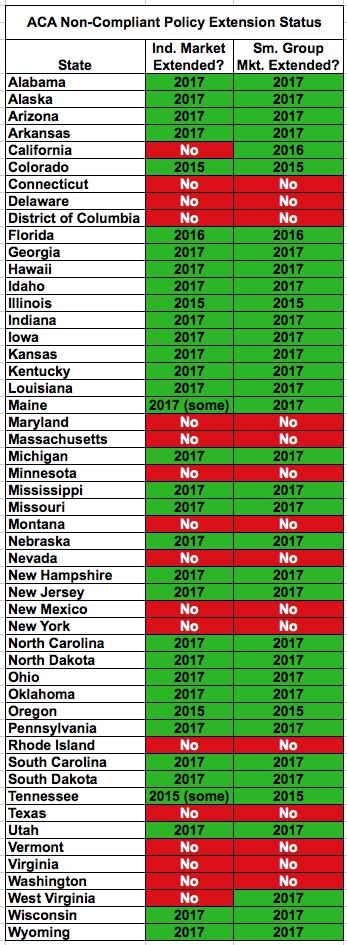Is *your* state extending non-compliant policies for a 2nd year?
Louise Norris of HealthInsurance.org is quickly becoming one of my favorite ACA enrollment colleagues (and competitors, after a fashion). The other day she wrote a far better-detailed writeup listing all of the improvements that the various exchanges have made for the 2015 open enrollment period than I did; and now she's also done the grunt work of tracking down the "grandfathered policy" status in all 50 states...although she refers to these plans as being "grandmothered" instead of grandfathered, with the following distinction:
Grandmothered – or transitional – plans are those that are not grandfatheredbut were effective prior to 2014. Grandfathered plans are allowed to remain in force indefinitely, without having to become fully compliant with the Affordable Care Act, as long as they don’t make changes that would substantially cut benefits or increase costs for insureds. Although most of Obamacare’s regulations don’t apply to grandfathered plans, grandmothered plans do have to adhere to some additional provisions of the health law.

Originally, all policies sold on the individual market had to meet the minimum ACA regulations as of 1/1/14. After the outcry about a couple millions policies being cancelled a year ago, President Obama and the HHS Dept. granted a 1-year extension of non-compliant policies...except with 2 caveats: First, it was up to each individual state's insurance commissioner to decide whether to allow the extension or not; and second, even in the states which did allow it, it was up to the individual insurance companies whether to allow it or not. Some states/companies took him up on the offer, others didn't.
Then, last spring, the HHS Dept. basically said "screw it" and bumped the extension waiver out by up to another 2 years (up to 3 total), figuring (accurately, in my view) that between the states/companies that didn't offer the extension, the ones that only bumped it out one or two years instead, and the massive amount of natural churn which takes place in the individual market every year anyway, that by the time we reach that "final" 3rd year deadline, there will be hardly anyone left with a non-compliant policy anyway, making it a moot point.
Anyway, Norris did a great job of contacting as many states as she could, and compiled a nicely-detailed breakdown of where things stand in every state.
While I admit to being a bit jealous that I didn't do this myself (I actually did do it last year, but never followed up for the additional 2nd/3rd year update), I take some solace in doing the one thing she didn't do: Put it into a simple chart format, as shown to the side.
In the interest of simplicity, I'm not going into as much detail as she did; I'm just including the individual & state markets, and whether each state is allowing extensions through 2015, 2016 or 2017.
As you can see, in about 1/3 of the states (including, believe it or not, Texas!), non-compliant policies were already killed off last fall or, in some cases, earlier this year (again, in Texas' case, they basically had to be replaced with ACA-compliant policies as they came up on their renewal date in 2014). In the other 2/3 of the states, existing policies are being allowed to renew all the way out to as late as 2017...in some cases. Again, just because the state is allowing a 2 or 3 year bump doesn't mean that every insurer is doing so.
As a result of this staggered, scattershot situation, some states/companies "ripped the band-aid off" so to speak last year; some are doing so this year; some next year and still others not until 2016.
The bad news is that this means that we'll be hearing the "OMG!! GAZILLIONS OF POLICIES CANCELLED!!" attacks for another 2 or 3 years to come. The good news is that the actual numbers involved should be fairly small in comparison to the claims each year. There may indeed have been perhaps 6 million non-compliant policies on the individual market a year ago, but that number is likely down to perhaps 3-4 million by now, and by the time 2017 comes around I'd be surprised if it's more than a hundred thousand or so total.
Why? Because even within the states which are allowing the extensions (whether by 1, 2 or 3 years), there's still a lot of people who will be dropping those non-compliant policies voluntarily. Some will age into Medicare, or fall on hard times and move onto Medicaid. Some will change jobs (or gain one) with employer-sponsored insurance. Some will move from one state to another and have to replace their policy anyway (unless it's a "multi-state" version). Some will marry someone with better coverage and drop theirs. Some...will die, frankly (hey, it happens to everyone).
So, even if a given state and every company operating within it allows the full 3-year extension, if they had, say, 100,000 non-compliant policies in place 1 year ago, there might only be, say, 70,000 still on those policies now. Of those, perhaps 40,000 will be on the same policy in October 2015, and perhaps only 10,000 in October 2016. By the time September 30, 2017 rolls around (the last possible date, barring another extension allowance), there will likely be practically no one left to complain about their policy being cancelled "due to Obamacare".
How to support my healthcare wonkery:
1. Donate via ActBlue or PayPal
2. Subscribe via Substack.
3. Subscribe via Patreon.



